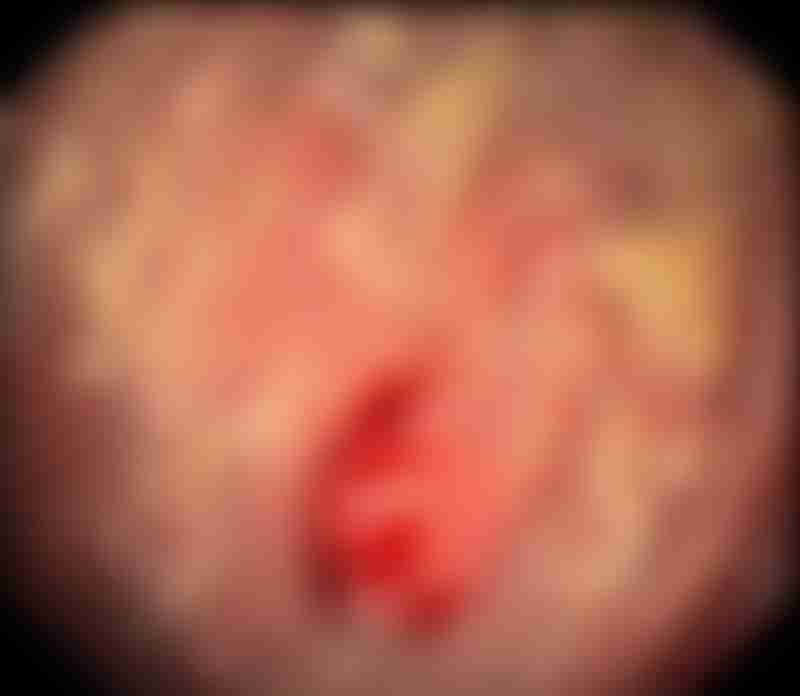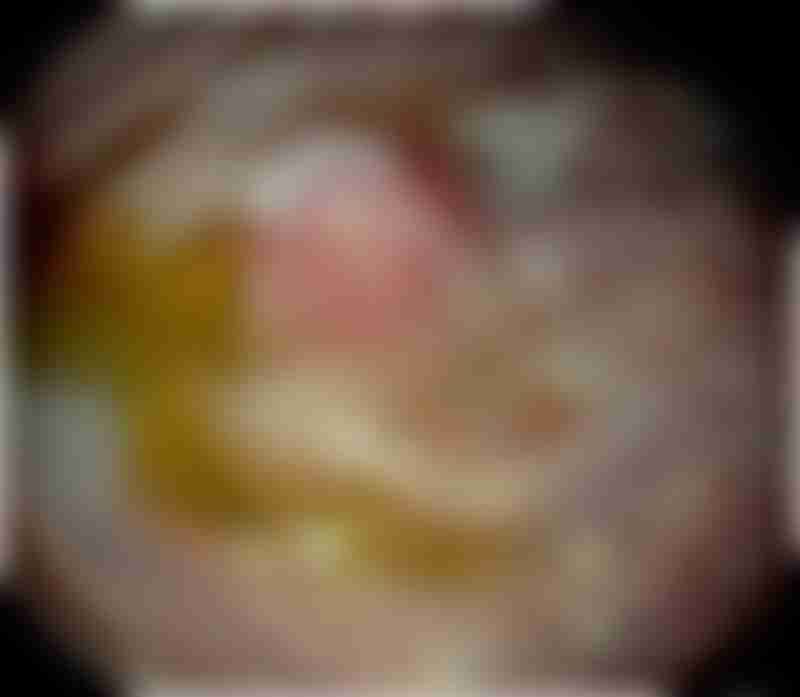Understanding Gastric Neuroendocrine Tumors

Source: Shutterstock
What is a gastric neuroendocrine tumor?
Neuroendocrine tumors (NETs) are rare cancers that can occur anywhere in the body. Those originating from neuroendocrine cells located in the stomach's mucosal lining are called gastric NETs. These specialized cells produce hormones controlling the release of gastric juices and how quickly food moves through the stomach.
Under normal conditions, these cells grow and divide to replace old or damaged cells that eventually die. However, when this process goes awry, abnormal or damaged cells can avoid cell death and continue to grow uncontrollably. This leads to the formation of a mass of cells called a tumor, which becomes malignant (cancerous) when it spreads and invades nearby tissues.
Learn more: Types of Cancers Within the Stomach

Endoscopic view of a neuroendocrine tumor and atrophic gastritis in the stomach lining. Source: Gastrolab/Science Photo Library
Slow-growing NETs that do not spread outside of the stomach are often described as low- or intermediate-grade (grade 1 or 2) carcinoid tumors, while rapidly-growing NETs that can invade nearby organs and tissues are called high-grade (grade 3) neuroendocrine carcinomas (NECs). While most gastric NETs are low- or intermediate-grade carcinoid tumors, some can become aggressive and behave in a similar way to NECs.
Learn more: Types and Grades of Gastric Neuroendocrine Tumors
Signs and symptoms
Many people suffering from gastric NETs do not experience any symptoms. In fact, early-stage gastric NETs are often discovered incidentally during tests and scans for other medical conditions, such as abdominal problems and indigestion. However, advanced NETs can cause a wide range of nonspecific symptoms, which include abdominal pain, nausea and vomiting.
> Find out more about the various symptoms of gastric NETs
In some rare instances, gastric NETs that have spread to the liver can give rise to symptoms such as flushing and swelling. This collection of symptoms, triggered by the release of hormones, is known as carcinoid syndrome.
> Find out more about syndromes associated with gastric NETs
Diagnosing gastric NETs

Endoscopic view of the stomach wall showing a neuroendocrine tumor in the gastric body region of the stomach. Source: Gastrolab/Science Photo Library
Once your doctors suspect that you may have a gastric NET, you will have to undergo a series of tests and/or scans to confirm your diagnosis. Examples include an upper endoscopy and biopsies. These diagnostic exams can also help to differentiate between gastric NETs and other cancers of the stomach.
Staging gastric NETs
Staging is the process of describing where a cancer is located and how far it has spread to other parts of the body, if at all. This determines the severity and extent of your cancer.
After confirming a gastric NET diagnosis, your doctors will need to determine the cancer’s stage. To do this, they use different types of exams, such as computed tomography (CT) and magnetic resonance imaging (MRI) scans.
> Find out what kinds of tests and scans are used to stage NETs
The information that your doctors gather from these tests and scans is then used to ascertain the stage of your gastric NET. Knowing the cancer’s stage helps your doctors predict the course of your condition (prognosis) and decide on the best treatment options for you.
Treating gastric NETs

Source: Shutterstock
When deciding on the best treatment options for you, your doctors will take several factors into consideration. These include:
- The size of the tumor, its location within the stomach and how far it has spread
- The type and grade of the neuroendocrine tumor(s)
- Whether the tumor is secreting hormones and causing related symptoms
This information will determine how aggressive the NET is, whether the tumor can be removed with surgery and if it can be targeted by certain medications.
Your treatment plan may involve different types of treatments, the most common of which are described below.
Surgery
Depending on factors such as the size, type and grade of the NET, the aim of surgery could be either curative or palliative. Curative surgery is primarily used to treat more localized tumors in the stomach. Meanwhile, palliative resection is mainly used for NETs that cannot be completely removed and/or have spread to distant organs, such as the liver.
> Find out more about surgery for gastric and metastatic NETs
Chemotherapy
Chemotherapy is a type of treatment that uses cancer-killing drugs to stop or slow the uncontrolled growth of cancer cells. It works by interfering with their DNA and the cell cycle, preventing the cells from dividing uncontrollably and effectively destroying them.
Low-grade gastrointestinal carcinoid tumors generally do not respond well to chemotherapeutic agents. Therefore, chemotherapy is mainly used for fast-growing carcinoid tumors or high-grade NECs that are unresectable and metastatic.
Hormone therapy
Some types of NETs are capable of releasing large amounts of hormones. These hormones can cause symptoms such as flushing, diarrhea and abdominal pain, collectively known as carcinoid syndrome. Localized gastric NETs usually do not secrete these hormones. However, circulating hormones can no longer be metabolized when these tumors spread from the stomach to the liver. This then leads to worsening carcinoid syndrome.
Hormone therapy is a type of cancer treatment that uses drugs called somatostatin analogs (SSAs) to block or lower the amount of these hormones. This helps to slow the growth of the tumor and relieve the symptoms of carcinoid syndrome.
> Find out more about hormone therapy for metastatic gastric NETs
Targeted therapy
Targeted therapy is a type of cancer treatment that uses drugs specifically designed to identify and attack cancer cells while limiting damage to healthy cells. It works by targeting the specific genes, proteins and tissue environments that are unique to NETs and play a vital role in their uncontrolled growth and survival. By inhibiting these targets, drugs used in this type of treatment can interfere with the cancer’s growth and spread within the body. Thus far, only one targeted therapy drug has been approved for use in the treatment of metastatic gastric NETs, which is everolimus.
> Find out more about everolimus and targeted therapy for metastatic gastric NETs
Radiation therapy
Radiation therapy, also known as radiotherapy, uses high-powered energy beams to kill cancer cells and prevent them from dividing. It damages the DNA of cancer cells located within the area where therapy is given. Subsequently, cancer cells with DNA that is beyond repair will stop dividing and die. These cells will start to die in the days or weeks after treatment begins and continue to die for weeks or months after treatment ends.
> Find out more about radiation therapy for metastatic gastric NETs
There is a special type of radiotherapy used to treat certain advanced gastroenteropancreatic NETs. This treatment is called peptide receptor radionuclide therapy (PRRT). PRRT uses a radioactively labeled drug called 177Lu-DOTATATE to target specific proteins that are present in excessive amounts on the surface of NET cells. When injected into your bloodstream, the drug delivers radiation to the tumor directly. This damages the cancer cells’ DNA and destroys them from within. In this way, PRRT selectively targets NETs while limiting damage to the surrounding healthy cells.
> Find out more about PRRT for advanced NETs
Interferon therapy
Interferon therapy is a type of immunotherapy used occasionally in the treatment of metastatic gastric NETs that cannot be removed surgically. Apart from slowing the growth of these tumors, interferon therapy can treat the symptoms of carcinoid syndrome. It is typically used in conjunction with SSAs such as octreotide.
While interferon therapy plays a multifaceted role in anticancer therapy by boosting your immune response and destroying cancer cells directly, its use is limited by its potentially adverse side effects. For this reason, interferon therapy is not regularly used in clinical practice today.
Liver-directed therapies
One of the most common sites of cancer spread in NETs is the liver. The burden of liver metastases means that circulating hormones may no longer be metabolized by the organ, which can cause symptoms of carcinoid syndrome.
If there are only one or two tumors in the liver, they would ideally be removed with surgery. However, if there are more than just a few of them, safely removing these liver tumors may not be possible without endangering your liver or your health. In these situations, your doctors may recommend liver-directed therapies to destroy as much tumor tissue as possible and relieve any cancer-related symptoms.
> Find out more about liver-directed therapies like ablation and embolization
Preventing gastric NETs
There is no sure way to prevent NETs or any other cancers of the stomach. However, there are some things you can do to lower your risk of developing gastric cancer in general. These include maintaining a diet of foods that have a protective effect against gastric cancer, and limiting your consumption of alcohol.
> Learn how you can take action to lower your gastric cancer risk
Life as a survivor of gastric NETs
If you’ve completed active treatment for your gastric NET and are now in the survivorship phase of your cancer journey, you may be experiencing a multitude of emotions. While many may feel relieved and excited for their lives beyond neuroendocrine cancer (NEC), others may find the transition to a “new normal” extremely daunting. Survivorship is different for every person who’s had a gastric NET or NEC.
> Find out more about what life after gastric cancer entails